1995 Lincoln Town Car Art 1986 Chrysler Lebaron Convertible
| Chrysler LeBaron | |
|---|---|
 Third generation LeBaron convertible | |
| Overview | |
| Manufacturer | Chrysler Corporation |
| Torso and chassis | |
| Class | Mid-size (1977–1995) Personal luxury (1986–1995) |
| Layout | FR layout (1931–1981) Transverse forepart-engine, front-wheel drive (1982–1995) |
| Chronology | |
| Successor | Chrysler New Yorker 5th Artery for rear-drive M-body version (1982) Chrysler 5th Avenue for rear-drive M-body version (1983) Chrysler Cirrus for front-drive sedan (1995) Chrysler Sebring for front-drive coupe (1995) Chrysler Sebring for convertible (1996) |
The Chrysler LeBaron, too known equally the Regal LeBaron, is a line of automobiles built by Chrysler from 1931-1941 and from 1955-1995. The model was introduced in 1931, with a body manufactured by LeBaron, and competed with other luxury cars of the era such as Lincoln and Packard. After purchasing LeBaron with its parent Briggs Manufacturing Company, Chrysler introduced the luxury make Imperial in 1955, and sold automobiles under the proper name Imperial LeBaron until 1975. Chrysler abased the Imperial make in 1975, and reintroduced the Chrysler LeBaron in 1977 to add prestige to what was then Chrysler'south everyman priced model. The "LeBaron" proper noun has since been applied to five different cars built past the Chrysler Segmentation:
- 1977–1981 K-body Mid-size LeBaron sedan, coupe, and railroad vehicle
- 1982–1988 K-trunk Mid-size LeBaron sedan, coupe, convertible, and wagon
- 1985–1989 H-body Mid-size LeBaron GTS hatchback
- 1987–1995 J-torso Personal luxury LeBaron coupe and convertible
- 1990–1994 AA-body Mid-size LeBaron sedan
The last Chrysler LeBaron was produced in 1995, to be replaced with the Cirrus and Sebring. The LeBaron was one of Chrysler'south longest running brands.
The LeBaron background [edit]

1941 Chrysler LeBaron Newport

1941 Chrysler Thunderbolt
LeBaron was i of the many prominent coachbuilders in the 1920s and 1930s to provide bodies for luxury cars. It was founded in Bridgeport, Connecticut in 1920 by Thomas L. Hibbard and Raymond H. Dietrich. It was afterwards purchased past Briggs Manufacturing Visitor of Detroit in 1926, the major manufacturer of bodies for Ford, Chrysler, Hudson, Packard and others, and operated as a Briggs specialist subsidiary.
LeBaron supplied exquisite custom bodies for diverse automobile companies such as Chrysler's luxury Regal line, Duesenberg, and Cadillac. LeBaron's last projects for Chrysler were the Chrysler Newport Phaeton, a super-streamlined dual cowl phaeton with an aluminum body and the remarkable 1941 Chrysler Thunderbolt, a sleek roadster with curtained headlights (like the 1936 String 810/812) and a retractable metal hardtop styled by Alex Tremulis, who would afterward fashion the legendary Tucker of 1948.[1] [two] [iii] [4]
Chrysler purchased Briggs Manufacturing Company in 1953.[4] Two years after the Chrysler Corporation introduced the Imperial equally a separate luxury partition, LeBaron was designated the top-of-the-line Imperial models in 1957 through 1975.[i] [2] [3] [iv]
Classic generation (1931–1941) [edit]
| Classic generation | |
|---|---|
 | |
| Overview | |
| Production | 1930s |
| Assembly | Detroit, Michigan, United states of america Bridgeport, Connecticut, United States[ane] [2] [3] [iv] |
| Body and chassis | |
| Class | Luxury |
| Body style | ii-door coupe 2-door convertible (roadster) 4-door sedan iv-door convertible |
| Layout | FR layout |
| Platform | Chrysler |
| Related | Chrysler Chrysler Royal |
| Powertrain | |
| Engine | 385 cuin (6.3L) Purple 8 I8[v] and others |
| Manual | 3-speed manual iv-speed transmission |
The LeBarons started in the 1930s during the automobile's Classic era and competed direct with the luxury brands of its day such as Lincoln, Cadillac, and Packard. In the mid-1930s, Chrysler added a radical new "Art Deco" design shape, known as the Airflow Imperials, to the Chrysler line. The high-cease CW series were supplied by LeBaron. The design features were considered advanced and possibly alee of their fourth dimension. However, the shape was too radical for buyer's tastes and non-Airflow models outsold Airflows by about iii to 1. Raymond Dietrich, co-founder and former stylist at LeBaron, was hired in 1932 to be Chrysler's in-house stylist. Dietrich restyled the Airflow line and Chryslers moved to more mainstream styles. Every bit a result of the poor Airflow sales, Chrysler blueprint actually became quite conservative for the next two decades. Car manufacturers connected to build up their in-house styling departments and bodyworks, with the event that LeBaron became less important to near of its customers for design ideas and bodies. Toward the late 1930s, LeBaron/Briggs built more bodies for Chrysler and fewer bodies for Ford. Chrysler became their biggest client, with additional bodies built for Packard, Hudson, and Graham-Paige. During the tardily 1930s and early on 1940s, the LeBaron name and partition became less important for Briggs, although information technology remained a division of Briggs until the Chrysler buy-out in 1953.[three] [4]
LeBaron'due south last projects for Chrysler were two concept cars: the Chrysler Newport Phaeton, a super-streamlined dual cowl phaeton with an aluminum body and the remarkable 1941 Chrysler Thunderbolt,[6] a sleek roadster with concealed headlights and a retractable metal hardtop[7] styled by Alex Tremulis, who went on to later mode function of the legendary Tucker of 1948. Only 6 of each were made.[1] [3]
Imperial generation (1955–1975) [edit]
| Imperial generation | |
|---|---|
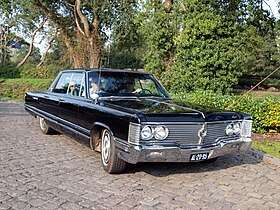 1968 Royal LeBaron | |
| Overview | |
| Product | 1956–1975 |
| Associates | Jefferson Avenue Assembly Detroit, Michigan, U.s.a. |
| Body and chassis | |
| Class | Full-size luxury |
| Body mode | 2-door hardtop four-door sedan iv-door hardtop |
| Layout | FR layout |
| Platform |
|
| Related |
|
| Powertrain | |
| Engine |
|
| Transmission | 3-speed automatic |
The Chrysler Corporation spun off the Imperial as a separate luxury make and partitioning in 1955. LeBaron was designated the top-of-the-line Majestic models from 1956 through 1975.[one] [two] [3] [4] These cars were Imperials and did not include the "Chrysler" nameplate. Vehicles branded "LeBaron" were the top model of the Regal line, followed by the mid-line "Crown" and a short-lived nameless base model ("Custom" from 1960 to 1963); with "Southampton" existence a sub-designation applied to all pillarless hardtops.
The Regal LeBarons were fabricated to compete directly with competitor'south luxury brands that included Continental, Cadillac, and Packard, as was the case during the 1930s.
The last Imperial model was assembled in June 1975, the discontinuation resulting from dwindling sales due to a recession, the furnishings of the 1970s free energy crunch, and the United States Congress having passed the Energy Policy and Conservation Deed, establishing Corporate Average Fuel Economic system standards.
-

1960 Imperial LeBaron
-
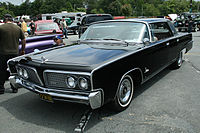
1964 Imperial LeBaron
-
1967 Imperial LeBaron
-
1972 Imperial LeBaron
-

1974 Royal LeBaron
Starting time generation (1977–1981) [edit]
| First generation | |
|---|---|
 | |
| Overview | |
| Production | 1977–1981 |
| Assembly | St. Louis, Missouri (Saint Louis Assembly), United States Newark, Delaware (Newark Associates), United states Valencia, Venezuela, Toluca, Mexico (Toluca Car Assembly)[8] Arica, Chile |
| Body and chassis | |
| Class | Mid-size |
| Body style | 5-door carriage (1978-81) 4-door sedan (1977-81) 2-door coupe (1977-81) |
| Layout | FR layout |
| Platform | M-trunk |
| Related | Chrysler Town and Country Dodge Diplomat Plymouth Gran Fury |
| Powertrain | |
| Engine | 225 in³ Slant-half dozen 318 in³ LA V8 360 in³ Chrysler LA engine#360 |
| Manual | 3-speed A727 automatic three-speed A904 automated |
| Dimensions | |
| Wheelbase | 112.vii in (ii,863 mm)[ix] 108.seven in (two,761 mm) (Coupe, 1980-81) |
| Length | 204 in (5,182 mm) (two-door) 206.ane in (5,235 mm) (4-door)[10] |
| Chronology | |
| Successor | Chrysler New Yorker Fifth Artery Chrysler Fifth Artery |

1977–1979 Chrysler LeBaron sedan

1977–1979 Chrysler LeBaron Medallion coupe
Although the LeBaron model name had been used before on Imperials, this was the first fourth dimension the proper noun was used equally a Chrysler model. Introduced in spring 1977 as a tardily 1977 model in response to the Cadillac Seville and Lincoln Versailles, the cars used the Dodge Aspen platform (F-body), but with a different body shell known as the Grand-body, and their primary purpose was as a luxury version of the Aspen/Volaré. The initial 1977 models comprised coupes and sedans, with a Boondocks & Country station wagon appearing for 1978 (using the nameplate formerly carried past full-sized C-body Chrysler wagons). The sedans and wagons, though considered M-bodies, were nearly identical to F-body Aspens and Volarés except for the hoods, trunk lids, and front and rear header panels.
The coupes differed more essentially; where the F-torso models utilized a 108.vii inch wheelbase coupe, M-bodies (which included the Contrivance Diplomat) used a unique coupe with styling evocative of the 1930s on the same 112.vii inch wheelbase as the sedans and wagons. Engines consisted of the 225-cid Camber Six, the 318 V8, and the 360 V8. Virtually were equipped with the three-speed Torqueflite automatic transmission, but a four-speed manual gearbox with an overdrive fourth gear was offered with the two smaller engines until 1981.

1980 LeBaron 5th Avenue Limited Edition; i of 654 produced
In 1979, the LeBaron was reskinned for the 1980 model year to gain more well-baked sheet metal, gaining a waterfall grille, new headlight fascias, and more angular taillamps. The rear roofline was also made shorter and steeper. The 2-door coupe received new smooth rear sheetmetal, that replaced the old curved rear panels, and was moved to the 108.7 inch wheelbase. On the inside, enhancements were fabricated to the interior to make information technology more luxurious. Also that year, a limited edition "Fifth Avenue" package was available with an contradistinct roofline and additional content; only 654 LeBarons were produced with this package, all converted by the American Sunroof Corporation. A law bundle was offered for 1981, afterward the demise of the Volaré. This was replaced by a new M-torso Plymouth Gran Fury for 1982, keeping Chrysler-Plymouth dealers in the competition for law enforcement contracts.
The LeBaron model name was moved to the new front-wheel drive K-platform for the 1982 model year. The former M-body LeBaron sedan became the Chrysler New Yorker and could notwithstanding be equipped with the Fifth Avenue package. The M-body wagons and coupes were discontinued after 1981. Chrysler'southward Chiliad-trunk sedan was ultimately renamed New Yorker Fifth Avenue for 1983 so just Fifth Artery starting in 1984. M-body Fifth Artery production continued through 1989 petty changed from the 1980-vintage LeBaron sedan.
For more information on this, please visit the Town & Country and 5th Artery sections.
Production Figures:
(For 1979 and 1981, coupe and sedan production figures are non separated)
| Coupe | Sedan | Railroad vehicle | Yearly Total | |
|---|---|---|---|---|
| 1977 | 7,280 | 12,600 | - | 19,880 |
| 1978 | 47,313 | 59,575 | 21,504 | 128,392 |
| 1979 | 96,400 | 17,463 | 113,863 | |
| 1980 | 24,530 | 31,010 | 7,939 | 63,479 |
| 1981 | 37,010 | 6,123 | 43,133 | |
| Full | 53,029 | 368,747 | ||
Second generation (1982–1988) [edit]
| Second generation | |
|---|---|
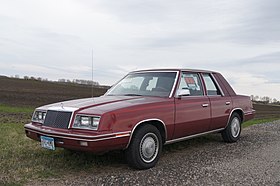 | |
| Overview | |
| Product | 1981–1988 |
| Model years | 1982–1988 |
| Assembly | Newark, Delaware, United states (Newark Assembly) St. Louis, Missouri, United States (Saint Louis Associates, Toluca, Mexico (Toluca Motorcar Assembly) |
| Torso and chassis | |
| Class | Mid-size executive car |
| Body manner | 5-door wagon (1982-88) 4-door sedan (1982-88) 2-door coupe (1982-86) 2-door convertible (1982-86) |
| Layout | Transverse front-engine, front-wheel bulldoze |
| Platform | K-body |
| Related | Chrysler Town & Country Contrivance 400 Dodge Aries Plymouth Reliant |
| Powertrain | |
| Engine |
|
| Transmission | 5-speed Getrag A525 manual iii-speed A413 automated 3-speed A470 automatic |
| Dimensions | |
| Wheelbase | 100.3 in (two,548 mm) |
| Length | 179.2 in (4,552 mm) |
| Width | 68 in (one,727 mm) |
| Height | 52.9 in (1,344 mm) |
For 1982, the LeBaron moved to the forepart-cycle drive Chrysler Thousand platform, where it was the upscale brand's everyman priced offer. Information technology was initially available in just sedan and coupe versions. In early 1982, it was released in a convertible version, bringing to the market the first factory-built open-topped domestic vehicle since the 1976 Cadillac Eldorado.
A station carriage version called the Town and Country was added as well. A special Boondocks and Country convertible was also made from 1983 to 1986 in limited quantities (1,105 total), which like the wagon featured simulated forest paneling that made information technology resemble the original 1940s Boondocks and Land. This model was part of the well-equipped Mark Cross pick packet for the latter years.
Despite being mechanically similar to the Aries and Reliant, its fascias closely resembled those of the larger Eastward-torso sedans. This generation featured Chrysler's Electronic Vocalism Alert, a computerized phonation which warned drivers about various atmospheric condition with phrases such as "A door is ajar" or "Your engine oil force per unit area is low".
The LeBaron was facelifted for 1986 receiving rounder front and rear ends to better aerodynamics. The sedan'southward full vinyl roof was replaced by a landau padded peak. The instrumentation cluster was revised from a rectangle speedometer and fuel gauge with a message center to round gauges similar to the Reliant/Aries just with a silver environment for a more upscale advent. Coupes and convertibles were dropped for 1987, being replaced by the all-new J-body LeBaron released that yr. The sedan and railroad vehicle continued with small-scale alter until 1988. A new digital dashboard replaced the analog gauges for a more modern appearance. A larger LeBaron sedan based on the Dodge Spirit and Plymouth Acclamation would arrive for the 1990 model yr.
-
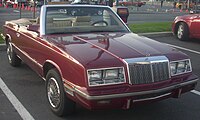
1985 Chrysler LeBaron convertible
-
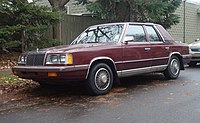
1987 Chrysler LeBaron sedan
-

1986 Chrysler LeBaron coupe
-

1986 Chrysler LeBaron Town & State convertible
-

1985 Chrysler LeBaron Town & Country station wagon
1985–1989 LeBaron GTS [edit]
| LeBaron GTS/LeBaron | |
|---|---|
 | |
| Overview | |
| Besides called | Chrysler GTS |
| Product | 1984–1989 |
| Model years | 1985–1989 |
| Associates | Sterling Heights, Michigan, United States |
| Body and chassis | |
| Class | Mid-size |
| Body style | five-door hatchback |
| Layout | Transverse front-engine, front-wheel bulldoze |
| Platform | H-body |
| Related | Dodge Lancer Shelby Lancer |
| Powertrain | |
| Engine |
|
| Transmission | 5-speed Getrag A520 manual 5-speed Getrag A555 transmission 3-speed A413 automatic |
| Dimensions | |
| Wheelbase | 103.1 in (2,619 mm) |
| Length | 180.four in (4,582 mm) |
| Width | 68.three in (1,735 mm) |
| Elevation | 53 in (1,346 mm) |
The 1985 LeBaron GTS was a somewhat different car than the standard LeBaron and was based on the Chrysler H platform. It was bachelor at the aforementioned fourth dimension as the Cadillac Cimarron as a luxury-brand model, while offering a like level of equipment to the small Cadillac. Equally a v-door hatchback however derived from the One thousand-car, the GTS (and the like Contrivance Lancer) was more of a operation vehicle than the softer-tuned K-auto LeBaron sedan. In base configuration, the car was powered by Chrysler's 2.2 liter inline-4 engine, after replaced by a 2.5 50 TBI version generating 100 hp (75 kW). A turbocharged ii.two L engine producing 146 hp (109 kW) was also available. The GTS moniker was dropped for 1989, the terminal year of this vehicle's production, after the K-based LeBaron sedan was discontinued after 1988. The last Chrysler LeBaron GTS rolled off the assembly line on April 7, 1989.
Trim levels [edit]
- High Line - 1985–1989
- Premium - 1985–1988
- GTS - 1989 (replaced "Premium" after the "GTS" was dropped from the name of the machine)
- "Pacifica" 1986 (replaced by Shelby Lancer in 1987) Limited 500 run
Production Figures:
| Coupe | Sedan | Wagon | Convertible | GTS | Yearly Total | |
|---|---|---|---|---|---|---|
| 1982 | 27,151 | 42,534 | 7,809 | 12,825 | - | 90,319 |
| 1983 | 18,331 | 30,869 | 10,994 | 9,891 | - | 70,085 |
| 1984 | 24,963 | 47,664 | 11,578 | 16,208 | - | 100,413 |
| 1985 | 24,970 | 43,659 | 7,711 | 16,475 | threescore,783 | 153,598 |
| 1986 | 24,761 | 40,116 | 19,684 | xix,684 | 73,557 | 177,802 |
| 1987 | - | 54,678 | five,880 | - | 39,050 | 99,608 |
| 1988 | - | 24,452 | 2,136 | - | fourteen,211 | 40,799 |
| Total | 120,176 | 283,972 | 65,792 | 75,083 | 187,601 | 732,624 |
European market - the Chrysler GTS [edit]
After some years of absence, Chrysler officially started offering some models nether its own make on the European market from Apr 1988 on. One of them was the "Chrysler GTS", which in fact was a rebadged version of the Dodge Lancer ES. Sales figures were moderate.
Third generation coupe/convertible (1987–1995) [edit]
| 3rd generation (coupe/convertible) | |
|---|---|
 | |
| Overview | |
| Also called | Chrysler Phantom (Mexico) |
| Production | 1986–1995 |
| Model years | 1987–1995 |
| Associates | Newark, Delaware, United States (Newark Assembly) St. Louis, Missouri, The states(Saint Louis Associates) Toluca, Mexico (Toluca Machine Associates) |
| Body and chassis | |
| Class | Personal luxury |
| Body mode | 2-door coupe (1987-93) ii-door convertible (1987-95) |
| Layout | Transverse front-engine, front end-wheel drive |
| Platform | J-body |
| Related | Chrysler TC by Maserati |
| Powertrain | |
| Engine |
|
| Transmission | 2.2 and 2.v L engines 5-speed Getrag A520 transmission 3.0 Fifty V6 engine 5-speed Getrag A543 manual |
| Dimensions | |
| Wheelbase | 100.five in (ii,553 mm) (1992–95 coupe) 100.6 in (2,555 mm) (1992–95 convertible) 100.3 in (ii,548 mm) (1987–1991 coupe) 100.4 in (2,550 mm) (1987–1991 convertible) |
| Length | 184.viii in (4,694 mm) |
| Width | 69.2 in (one,758 mm) (1992–95) 68.5 in (i,740 mm) (1987–1991) |
| Acme | 51.2 in (i,300 mm) (1992–95) 50.nine in (i,293 mm) (1987–1991) |

1987–1992 LeBaron Coupe (headlight covers open up)
Afterwards discontinuing the get-go generation LeBaron coupe and convertible in 1986, Chrysler released a new LeBaron for 1987, built on the J platform (a K platform derivative) and available as a coupe or convertible. The all-new LeBaron looked modernistic and aerodynamic compared to its boxy predecessor and was quite stylish for its day, featuring headlights subconscious behind retractable metallic covers and a waterfall grille, steeply raked windshield, full-width taillight lenses though only the edges really lit up, and curved (Coke bottle) style rocker panels. The LeBaron was equipped with a trip & fuel economic system reckoner and full instrumentation. In Mexico, these models were marketed every bit the Chrysler Phantom. The available engines were the stock 2.2-liter and 2.five-liter, naturally aspirated or turbocharged, and for the 1990 model year, a iii.0-liter Mitsubishi V6 became bachelor, although the Mexican Chrysler Phantom R/T DOHC 16V as well offered the same ii.2-liter turbo engine as used in the U.Due south. marketplace Contrivance Spirit R/T.

For 1990, the LeBaron'southward interior was refreshed, featuring an all new dashboard, estimate cluster, door panels, and heart console design. All of the new components were designed to exist smoother and more flowing than the insufficiently boxy 1987-89 interior style, making it more in melody with the "aero" revolution of the early on 1990s. The 1992 LeBaron coupes and convertibles could be ordered with a new "sport bundle", which featured a monochrome advent including torso-colored grille, accent stripe, and decklid logo. The package also included 14-inch "lace" style wheelcovers and a black strip beneath the taillights in place of chrome, with special blacked-out window moldings on coupe models.[13]
1993 Facelift [edit]

1993–1995 Chrysler LeBaron convertible

1994 interior (aftermarket radio)
In 1992 for the 1993 model year, the LeBaron received a slight facelift. The subconscious headlamps of the 1987-1992 models were deleted in favor of less costly flush-mounted replaceable-seedling headlamps, new bicycle styles were made available, and all models got the amber rear turn signals introduced on the deluxe 1992 models. For 1994, a passenger side airbag became standard on all models. Also new for 1994 was the "Bright LX" decor package which included a "bright" chrome grille, "bright" chrome badging, and "bright" chrome molding inserts, every bit opposed to being body-colored on the GTC.
The available engines were a naturally aspirated ii.5 L and a turbocharged 2.ii and 2.5 L versions of Chrysler'southward inline-four, and the 3.0 L Mitsubishi V6 making a 141 hp (105 kW) in this application. The turbocharged engines were dropped from the lineup in 1992 for the 1993 model year. The coupe was discontinued after 1993. In 1994 the 3.0 was the simply available engine. The convertible was discontinued after 1995, to brand way for the new Chrysler Sebring coupes and convertibles, for 1995 and 1996 respectively.
Trim levels: 1987–1995 [edit]
Throughout its lifetime, the LeBaron convertible/coupe was available in many trim levels. For its offset year, the LeBaron was available in Highline and Premium, typical Chrysler trims at the time. The number of trims grew, peaking in 1990, with six available. Later that, the number decreased until just 2 trim levels remained for 1995.
- 1987: Highline, Premium
- 1988: Highline, Premium, GT
- 1989: GTS Turbo, GT Turbo, GTC Turbo, Highline, Premium
- 1990: GT, GT Turbo, GTC Turbo, Highline, Highline Turbo, Premium
- 1991: GTC, GTC Turbo, Highline, Highline Turbo, Premium 60
- 1992: GTC, GTC Turbo, Highline, Highline Turbo, Sixty
- 1993: GTC, Highline, Sixty
- 1994: GTC, LX
- 1995: GTC, Threescore
Racing [edit]
Several ARCA (one tier downwardly from NASCAR loving cup racing) teams built LeBaron based race cars (supported by a revitalized Chrysler Directly Connection performance parts division) and ran them from 1988 to 1998. The cars were very competitive and won several races during those years. Production Figures:
| Coupe | Convertible | Yearly Total | |
|---|---|---|---|
| 1987 | 75,415 | 8,025 | 83,440 |
| 1988 | 48,671 | 38,197 | 86,868 |
| 1989 | 53,504 | 37,489 | 90,993 |
| 1990 | 20,106 | 38,928 | 59,034 |
| 1991 | 10,771 | 29,074 | 39,845 |
| 1992 | 5,656 | twoscore,284 | 45,940 |
| 1993 | 6,007 | 26,776 | 32,783 |
| 1994 | - | 37,052 | 37,052 |
| 1995 | - | 35,760 | 35,760 |
| Total | 220,130 | 291,585 | 511,715 |
Tertiary generation sedan (1990–1994) [edit]
| Third generation (sedan) | |
|---|---|
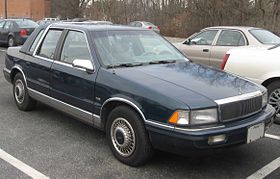 | |
| Overview | |
| Also called | Chrysler New Yorker (United mexican states) |
| Production | 1989–1994 |
| Model years | 1990–1994 |
| Assembly | Newark, Delaware, U.s.a. (Newark Associates) Toluca, Mexico (Toluca Car Assembly) Valencia, Carabobo, Venezuela |
| Torso and chassis | |
| Class | Mid-size |
| Body style | 4-door sedan |
| Layout | Transverse front-engine, front-wheel drive |
| Platform | AA-trunk |
| Related | Chrysler Saratoga (Export only) Dodge Spirit Plymouth Acclamation |
| Powertrain | |
| Engine |
|
| Transmission |
|
| Dimensions | |
| Wheelbase | 103.five in (2,629 mm) |
| Length | 182.7 in (4,641 mm) |
| Width | 68.1 in (one,730 mm) |
| Pinnacle | 53.7 in (1,364 mm) |
| Curb weight | 2,971 lb (i,348 kg) |
| Chronology | |
| Successor | Chrysler Cirrus |
The last LeBaron sedan was congenital on the front end wheel bulldoze AA platform, another 1000 derivative, equally junior level sedan to the more upscale New Yorker. It offered rebadged versions under the Dodge Spirit and Plymouth Acclaim nameplates, and the three differed generally in particular and trim choices, besides equally the European Chrysler Saratoga.
Theoretically, as historically was the instance in this era whenever Chrysler, Dodge, and Plymouth shared direct model variants, the Acclaim was supposed to be the more than mainstream version, while the Spirit was the sportier version, and the LeBaron was the luxury version, reflecting the Chrysler make's flagship status. In reality, notwithstanding, there was considerable overlap amongst the three in available trim, equipment and features. The top-line LeBaron Landau model offered a padded vinyl half-roof with smaller "formal" backlight. All LeBaron sedans came with a standard driver'south side airbag, and could seat up to half dozen passengers.

For 1992, the LeBaron sedan was carve up into 3 trim levels: base, LX and Landau. The new entry model eliminated the previously standard V6 engine and landau vinyl roof while the Landau model still included the landau roof every bit standard. The 60, bachelor one year only, offered standard V6 but no landau roof. For 1993, the LeBaron sedan received new rear lights, which incorporated the reversing lamps previously located in the bumper fascia and the lineup was reduced to 2 trim levels with the entry model now labeled LE. The LeBaron sedan was discontinued on May xviii, 1994 while the Dodge Spirit and Plymouth Acclaim continued production until Dec 21, 1994. The Chrysler LeBaron was replaced by the "Deject Car" Chrysler Cirrus.
Prophylactic [edit]
In 1994, the U.South. National Highway Traffic Safety Assistants rated the LeBaron[ which? ] a iv out of 5 for driver side and a 3 out of v for passenger side frontal impact occupant protection.[ citation needed ]
Trim levels [edit]
- base - 1990–1992
- LX - 1992
- Landau - 1992–1994
- LE - 1993–1994
Production Figures:
| Yearly Production | |
|---|---|
| 1990 | 27,312 |
| 1991 | 17,752 |
| 1992 | 33,862 |
| 1993 | 26,474 |
| 1994 | 35,760 |
| Total | 141,160 |
Mexican market [edit]
M and Chiliad-platform cars were assembled in the Toluca, Mexico facility. The M-platform LeBaron was sold in Mexico from the 1977 to the 1982 model years. The K-car LeBaron was also produced in Toluca and was sold for the 1983 through 1987 model years. There were no Thousand-platform convertibles offered from the mill.
Chrysler Phantom was the Mexican-market version of the J-Body LeBaron Coupe. There were no convertibles of the J-body two-door for the Mexican market. Phantoms were Chrysler's top-of-the-line model in Mexico and more often than not sold with a higher trim level than their United States counterparts; the Phantom was also only ever available with the more powerful, turbocharged engines.[xvi] Chrysler Phantoms were marketed from 1987 to 1994, with the showtime cars delivered in December 1986.[17] A more powerful R/T version (similar to the American LeBaron GTC but using a higher-tuned turbo engine) was also available in 1992 and 1993. The Phantom R/T originally received the 2.5-liter 175 hp (130 kW) Turbo II engine, coupled to a three-speed automated, just this was quickly changed to the 224 hp (167 kW) Turbo III engine with a 5-speed Getrag manual transmission.[xvi]
The Mexican AA-body Chrysler LeBaron 4-door sedan was called the New Yorker (all of them with Landau roof), and the "K" body (slightly shorter) was reserved for the 4-door LeBaron'south, which were sold in ii trim levels, one with Landau roof and leather, and the other 1 without those two options.
References [edit]
- ^ a b c d e "Chrysler LeBaron History". Webspace.webring.com. Archived from the original on 2011-08-25. Retrieved 2010-x-04 .
- ^ a b c d "1985 Chrysler LeBaron Images, Information and History (LeBaron Town & Country, LeBaron Mark Cantankerous Convertible, T&C, LeBaron GTS, LS Sedan)". Conceptcarz.com. Archived from the original on 2011-06-13. Retrieved 2010-10-04 .
- ^ a b c d e f "Coachbult.com - LeBaron - Le Baron - LeBaron Carrossiers - LeBaron Inc. - LeBaron-Detroit". Coachbuilt.com. Archived from the original on 2010-08-02. Retrieved 2010-10-04 .
- ^ a b c d e f "Briggs Trunk Company, Brggs Mfg, Co., Walter O. Briggs, LeBaron, Briggs Detroit, John Tjaarda, Coachbult.com". Coachbuilt.com. Archived from the original on 2010-09-01. Retrieved 2010-x-04 .
- ^ "1931 Chrysler Imperial Close Coupled Sedan". Imperialclub.com. 1930-07-14. Archived from the original on 2010-06-29. Retrieved 2010-10-04 .
- ^ "Special Built Cars Hint Tomorrow's Designs". Popular Mechanics. Hearst Magazines. January 1941.
- ^ Janicki, Edward (1990). Cars Detroit Never Built: L Years of American Experimental Cars. New York, NY: Sterling Publishing Company. p. 12. ISBN0806974249.
- ^ "1978 Chrysler LeBaron (VE)". Dkarros.com. Archived from the original on 2011-07-10. Retrieved 2010-10-04 .
- ^ http://oldcarbrochures.org/December%202019/1977%20Chrysler%20LeBaron/slides/1977%20Chrysler%20LeBaron%20page_13.html
- ^ http://oldcarbrochures.org/Dec%202019/1977%20Chrysler%20LeBaron/slides/1977%20Chrysler%20LeBaron%20page_13.html
- ^ Flammang, James Thousand. (1999). Standard itemize of American cars, 1976-1999. Ron Kowalke (third ed.). Iola, WI: Krause Publications. ISBN0-87341-755-0. OCLC 43301709.
- ^ Flammang, James Chiliad. (1999). Standard itemize of American cars, 1976-1999. Ron Kowalke (3rd ed.). Iola, WI: Krause Publications. ISBN0-87341-755-0. OCLC 43301709.
- ^ 1992 Chrysler LeBaron Mill Sales Brouchure
- ^ Flammang, James M. (1999). Standard catalog of American cars, 1976-1999. Ron Kowalke (tertiary ed.). Iola, WI: Krause Publications. ISBN0-87341-755-0. OCLC 43301709.
- ^ Flammang, James M. (1999). Standard catalog of American cars, 1976-1999. Ron Kowalke (3rd ed.). Iola, WI: Krause Publications. ISBN0-87341-755-0. OCLC 43301709.
- ^ a b Stopford, William (2016-12-12). "Mexican Mopars, Part 4: 1987-94 Chrysler Phantom – The Camargue of Mexican Chryslers". Curbside Classics. Archived from the original on 2020-xi-29.
- ^ Stark, Harry A., ed. (1987). Ward's Automotive Yearbook 1987. Vol. 49. Detroit, MI: Ward'south Communications, Inc. p. 86. ISBN0910589007.
{{cite book}}: CS1 maint: ignored ISBN errors (link)
Sources [edit]
- Coachbuilt: LeBaron Carrossiers - 1920-1925, LeBaron Inc. - 1925-1928, LeBaron-Detroit - 1928-1942
- Coachbuilt: Briggs Manufacturing Co. - 1909-1954
- Conceptcarz: Chrysler LeBaron news
- Allpar: LeBaron Coupe
- Consumer Guide: 1990-1995 LeBaron coupe/convertible reviews
- Consumer Guide: 1990-1994 LeBaron Sedan reviews
- Front-Runners.cyberspace - LeBaron Road Exam (PDF)
External links [edit]
- Chrysler LeBaron History
- Chrysler Le Businesswoman GTC
- MyLebaron
- LeBaron.de - German Forum, Gallery, KnowHow...
- Chrysler K-auto Club
Source: https://en.wikipedia.org/wiki/Chrysler_LeBaron
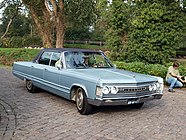

0 Response to "1995 Lincoln Town Car Art 1986 Chrysler Lebaron Convertible"
Post a Comment